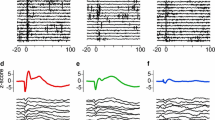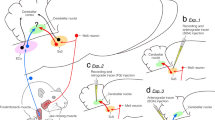Summary
Movements elicited by the stimulation of the cerebellar nuclei were studied in alert baboons chronically prepared. The motor responses were filmed and recorded in eight muscles through chronically implanted electrodes.
Two types of motor effects were observed: (1) Simple movements that concerned the unidirectional displacement of a limb segment. (2) Complex movements that involved distinct and frequently noncontiguous muscles were stereotyped and could not be dissociated. These movements are defined as motor synergies.
Electromyographic study allowed us to investigate the motor response latencies and the modality of cerebellar control on musculature. Simple movements were due to the activation of muscles within the involved segment in addition to the co-contraction of muscles of a nearby segment. Thus they could be due to a cerebellar control over muscular synergies. Complex movements would correspond to the simultaneous activation of distinct muscular groups and could also be the outcome of a cerebellar control on motor synergies.
Thus the effects of the interposed nucleus concern preferably flexor muscles whereas the effects of the dentate nucleus appear to be equally distributed among flexor and extensor muscles.
Somatotopic motor localization were evidenced both in the interposed and dentate nuclei: there are somatotopic relations between every region of the interposed nucleus and musculature. As regards the dentate nucleus, two subdivisions were distinguished according to the complexity of elicited motor effects: (A) an antero-medial region from which motor synergies can be elicited. (B) a postero-lateral region giving rise to simple movements, mainly hand movements.
Similar content being viewed by others
References
Allen GI, Gilbert PFC, Marini R, Schultz W, Yin TCT (1977) Integration of cerebral and peripheral inputs by interpositus neurons in the monkey. Exp Brain Res 27: 81–99
Allen GI, Gilbert PFC, Yin TCT (1978) Convergence of cerebral inputs onto dentate neurons in monkey. Exp Brain Res 22: 151–170
Allen GI, Tsukahara N (1974) Cerebrocerebellar communication systems. Physiol Rev 54: 957–1006
Angaut P, Bowsher D (1970) Ascending projections of the medial cerebellar (fastigial) nucleus: An experimental study in the cat. Brain Res 24: 49–68
Asanuma H, Hunsperger RW (1975) Functional significance of projection from the cerebellar nuclei to the motor cortex in the cat. Brain Res 98: 73–93
Babinski J (1899) De l'asynergie cérébelleuse. Rev Neurol (Paris) 7: 806–816
Babinski J (1909) Quelques documents relatifs à l'histoire des fonctions de l'appareil cérébelleux et de leurs perturbations. Rev Mens Med Int Ther 1: 113–129
Bantli H, Bloedel JR (1976) Characteristics of the output from the dentate nucleus to spinal neurons via pathways which do not involve the primary sensorimotor cortex. Exp Brain Res 25: 199–220
Batini C, Pompeiano O (1955) Sugli effetti di distruzioni croniche, partiali o totali del nucleo del tetto nel gatto. Boll Soc Ital Biol Sper 31: 805–807
Beaubaton D, Trouche E, Amato G, Grangetto A (1978) Dentate cooling in monkeys performing a visuo-motor task. Neurosci Lett 8: 225–229
Botterell EH, Fulton JF (1938) Functional localization in the cerebellum of primates. III. Lesions of hemispheres (neocerebellum). J Comp Neurol 69: 63–87
Boyle R, Pompeiano O (1979) Sensitivity of interpositus neurons to neck afferent stimulation. Brain Res 168: 180–186
Bremer F (1935) Le cervelet. In: Binet GH, Binet L (eds) Traité de physiologie normale et pathologique, vol 10. Masson, Paris, pp 149–479
Brooks VB (1979) Control of intented limb movements by the lateral and intermediate cerebellum. In: Asanuma H, Wilson VJ (eds) Integration in the nervous system. Igaku-Shoin, Tokyo New York, pp 321–357
Brooks VB, Kozlovskaya IB, Atkin A, Horvath EE, Uno M (1973) Effects of cooling dentate nucleus on tracking. Task performance in monkeys. J Neurophysiol 2: 974–995
Burton JE, Onoda N (1977) Interpositus neuron discharge in relation to a voluntary movement. Brain Res 121: 167–172
Carpenter MB (1959) Lesions of the fastigial nuclei in the rhesus monkey. Am J Anat 104: 1–34
Chambers WW, Sprague JM (1955) Functional localization in the cerebellum. I. Organization in longitudinal cortico-nuclear zones and their contribution to the control of posture. Both extrapyramidal and pyramidal. J Comp Neurol 103: 105–129
Chan-Palay V (1977) Cerebellar dentate nucleus. Organization, cytology and transmitters. Springer, Berlin Heidelberg New York, p 549
Demote V (1927) Structure et connexions des noyaux dentelés du cervelet. Schweiz Arch Neurol Psychiat 271: 293–315
Dow RS, Moruzzi G (1958) The physiology and pathology of the cerebellum. University of Minnesota Press, Minneapolis, p 675
Ghez C (1975) Input-output relations of the red nucleus in the cat. Brain Res 98: 93–108
Gilman S (1969) The mechanism of cerebellar hypotonia. Brain 92: 621–638
Gilman S, McDonald WI (1967) Cerebellar facilitation of muscle spindle activity. J Neurophysiol 30: 1494–1512
Goldberger ME, Growdon JH (1973) Pattern of recovery following cerebellar deep nuclear lesions in monkeys. Exp Neurol 39: 307–322
Growdon JH, Chambers HW, Liu CN (1967) An experimental study of cerebellar dyskinesia in the rhesus monkey. Brain 90: 603–632
Harvey RJ, Porter R, Rawson JA (1979) Discharges of intracerebellar nuclear cells in monkeys. J Physiol (Lond) 297: 559–580
Heimburger F (1970) The role of the cerebellar nuclei in spasticity. Confin Neurol 32: 105–113
Holmes G (1917) The symptoms of acute cerebellar injuries due to gunshot injuries. Brain 40: 461–535
Holmes G (1939) The cerebellum of the man. Brain 62: 1–29
Kongo T, Jankowska E, Lundberg A (1969) The rubrospinal tract. II. Facilitation of interneuronal transmission in reflex paths to motoneurones. Exp Brain Res 7: 365–391
Jankowska E, Padel Y, Tanaka R (1975) The mode of activation of pyramidal cells by intracortical stimuli. J Pysiol (Lond) 249: 617–636
Kozlovskaya IB, Atkin A, Horvath FE, Uno M, Brooks VB (1973) Mechanisms of motor control of two types of tracking movements in monkeys. Agressologie 14: 49–59
Knutsson E, Meyerson BA (1972) Distribution of electromyographic changes following stereotaxic stimulation and destruction of cerebellar nuclei in cerebral plasy. In: Somjen GG (ed) Neurophysiology studies in man. Excerpta Medica, Amsterdam, pp 370–379
Larsen KD, Yumiya H (1979) Organization of the convergence in the intermediate cerebellar nuclei of somatosensory receptive fields with motor cortical evoked responses. Exp Brain Res 36: 477–491
Lundberg A (1975) Control of spinal mechanisms from the brain. In: Tower DB (ed) The nervous system. The basic neurosciences, vol I. Raven Press, New York, pp 253–265
Massion J, Sasaki K (1979) Cerebro-cerebellar interactions: Solved and unsolved problems. In: Massion J, Sasaki K (eds) Cerebro-cerebellar interactions. Elsevier/North-Holland Biomedical Press, Amsterdam, pp 261–287
Meulen JP van der, Gilman S (1965) Recovery of muscle spindle activity in cats after cerebellar ablation. J Neurophysiol 28: 943–957
Moruzzi G, Pompeiano O (1956) Crossed fastigial influence on decerebrate rigidity. J Comp Neurol 106: 371–392
Nadvornik P, Sramka M, Lisy L, Svicka I (1972) Experiences with dentatomy. Confin Neurol 34: 320–324
Nashold BS, Slaughter DG (1969) Effects of stimulating or destroying the deep cerebellar regions in man. J Neurosurg 31: 172–186
Padel Y, Steinberg R (1978) Red nucleus cell activity in awake cats during a placing reaction. J Physiol (Paris) 74: 265–282
Perciavalle V, Santangelo F, Sapienza S, Savoca F, Urbano A (1977) Motor effects produced by microstimulation of brachium pontis in the cat. Brain Res 126: 557–562
Perciavalle V, Santangelo F, Sapienza S, Serapide MF, Urbano A (1978) Motor responses evoked by microstimulation of restiform body in the cat. Exp Brain Res 33: 241–255
Peterson BW, Maunz RA, Pitts NG, Mackel RG (1975) Patterns of projection and branching of reticulospinal neurons. Exp Brain Res 23: 333–351
Pompeiano O (1967) Functional organization of the cerebellar projections to the spinal cord. Prog Brain Res 25: 282–321
Rand RW (1954) An anatomical and experimental study of the cerebellar nuclei and their efferent pathways in the monkey. J Comp Neurol 101: 167–223
Rispal-Padel L (1979) Functional characteristics of the cerebello-thalamo-cortical pathway in the cat. In: Massion J, Sasaki K (eds) Cerebro-cerebellar interactions. Esevier/North-Holland Biomedical Press, Amsterdam, pp 67–103
Rispal-Padel L, Grangetto A (1977) The cerebello-thalamo-cortical pathway. Topographical investigation at the unitary level in the cat. Exp Brain Res 28: 101–123
Rispal-Padel L, Latreille J (1974) The organization of projections from the cerebellar nuclei to the contralateral motor cortex in the cat. Exp Brain Res 19: 36–60
Rispal-Padel L, Massion J, Grangetto A (1973) Relations between the ventrolateral thalamic nucleus and motor cortex and their possible role in the central organization of motor control. Brain Res 60: 1–20
Rispal-Padel L, Cicirata F, Pons JC (1981) Contribution of the dentato-thalamo-cortical system to control of motor synergy. Neurosci Lett 22: 137–144
Rispal-Padel L, Ciciratta F, Pons JC (in prep.) Studies of the cerebello-cortical projections in the chronic monkey.
Robertson LT, Grimm RJ (1975) Responses of primate dentate neurons to different trajectories of the limb. Exp Brain Res 23: 447–463
Rondot P, Bathien N, Toma S (1979) Physiopathology of cerebellar movement. In: Massion J, Sasaki K (eds) Cerebro-cerebellar interactions. Elsevier/North-Holland Biomedical Press, Amsterdam, pp 203–230
Sasaki K (1979) Cerebro-cerebellar interconnections in cats and monkeys. In: Massion J, Sasaki K (eds) Cerebro-cerebellar interactions. Elsevier/North-Holland Biomedical Press, Amsterdam, pp 105–124
Sasaki K, Tanaka T (1963) Effects of stimulation of cerebellar and thalamic nuclei upon spinal alpha motoneurons of the cat. Jpn J Physiol 13: 64–83
Sasaki K, Kawaguchi S, Oka H, Sakai H, Mizuno N (1976) Electro-physiological studies on the cerebellocerebral projections in monkeys. Exp Brain Res 24: 495–507
Schultz W, Montgomery EB, Marini R (1979) Proximal limb movements in response to microstimulation of primate dentate and interpositus nuclei mediated by brain-stem structures. Brain 102: 127–146
Shinoda Y, Arnold AP, Asanuma H (1976) Spinal branching of corticospinal axons in the cat. Exp Brain Res 26: 215–234
Siegfried J (1969) Functional anatomy of the dentate at the 4th Symp on Extrapyramidal Disorders. Internat Soc Res Stereo encephal, New York
Siegfried J, Esslen E, Gretener U, Kretz E, Peret E (1970) Functional anatomy of the dentate nucleus in the light of stereotaxic operations. Confin Neurol 32: 1–10
Smith AM, Bourdonnais D (1981) Neuronal acitivity in cerebellar cortex related to control of prehensile force. J Neurophysiol 45: 286–304
Stanton GB (1980) Topographical organization of ascending cerebellar projections from the dentate and interposed nuclei in Macaca Mulatta: An anterograde degeneration study. J Comp Neurol 190: 699–731
Strick PL (1976) Cerebellar neuron response to imposed limb displacement: Dependence of short latency dentate activity on intended movement. Abstr Soc Neurosci 2: 876
Strick PL (1979) Control of peripheral input to the dentate nucleus by motor preparation. In: Massion J, Sasaki K (eds) Cerebro-cerebellar interactions. Elsevier/North-Holland Biomedical Press, Amsterdam, pp 185–201
Thach WT (1970) Discharge of cerebellar neurons related to two maintained postures and two prompt movements. I. Nuclear cell output. J Neurophysiol 33: 527–536
Thach WT (1978) Correlation of neural discharge with pattern and force of muscular activity, joint position and direction of intended next movement in motor cortex and cerebellum. J Neurophysiol 41: 654–676
Thomas A (1925) Le cervelet. In: Widal F, Tissier PJ (eds) Nouveau traité de médecine. Massen, Paris, pp 755–980
Toth S (1961) The effect of the removal of the nucleus dentate on the parkinsonian syndrome. J Neurol Neurosurg Psychiatry 24: 143–147
Verdie JC (1975) Le noyau dentelé. Thése de Doctorat d'Etat en Médecine. Université Paul Sabatier, Toulouse, p 178
Voogd JMD (1964) The cerebellum of the cat. Structure and fibre connections. Van Gorcum, Assen, p 215
Zervas NT, Horner FA, Pickren KS (1967) The treatment of dyskinesia by stereotaxic dentatectomy. Confin Neurol 29: 93–100
Author information
Authors and Affiliations
Additional information
Supported by grant “ATP DGRST 1950”
Rights and permissions
About this article
Cite this article
Rispal-Padel, L., Cicirata, F. & Pons, C. Cerebellar nuclear topography of simple and synergistic movements in the alert baboon (Papio papio). Exp Brain Res 47, 365–380 (1982). https://doi.org/10.1007/BF00239355
Received:
Issue Date:
DOI: https://doi.org/10.1007/BF00239355




